How does a bug living in chaotic aquatic habitats tune its biochemistry for survival? Delighted to share our preprint describing the function of membraneless organelles in Caulobacter (CB) that tune signaling robustly under famine and feast. A  https://abs.twimg.com/emoji/v2/... draggable="false" alt="🧵" title="Thread" aria-label="Emoji: Thread">(1/14) https://tinyurl.com/yyncbncu ">https://tinyurl.com/yyncbncu&...
https://abs.twimg.com/emoji/v2/... draggable="false" alt="🧵" title="Thread" aria-label="Emoji: Thread">(1/14) https://tinyurl.com/yyncbncu ">https://tinyurl.com/yyncbncu&...
CB is a freshwater bacterium that lives in aquatic bodies. These water bodies have very low glucose levels. About 10000-times lower than the lab media. So, how does the bug tune biochemical reactions that are dependent on the products of metabolism in the wild? 2/14
To answer this question we focused on a critical reaction in CB: DivJ phosphorylation. DivJ is a kinase whose polar localization is key for cell division. SpmX interacts with DivJ for its polar localization. SpmX also interacts with PopZ in the cytoplasm to get to the pole.3/14
We report that PopZ and SpmX are 2 interacting MLOs formed by liquid-liquid phase separation. We present multiple lines of indirect evidence for LLPS (Sorry! #TinyBugs). Cool. Blobs. But what& #39;s the physiological relevance? We found that SpmX condensate tunes DivJ activity. 4/14
For a cooperative reaction (such as DivJ phosphorylation), localization via structured protein interactions ( https://abs.twimg.com/emoji/v2/... draggable="false" alt="🔒" title="Schloss" aria-label="Emoji: Schloss"> and
https://abs.twimg.com/emoji/v2/... draggable="false" alt="🔒" title="Schloss" aria-label="Emoji: Schloss"> and  https://abs.twimg.com/emoji/v2/... draggable="false" alt="🔑" title="Schlüssel" aria-label="Emoji: Schlüssel">) could have sufficed. However, the SpmX-DivJ interaction is mediated by the SpmX-IDR. Why use a charged and disordered condensate for this job? 5/14
https://abs.twimg.com/emoji/v2/... draggable="false" alt="🔑" title="Schlüssel" aria-label="Emoji: Schlüssel">) could have sufficed. However, the SpmX-DivJ interaction is mediated by the SpmX-IDR. Why use a charged and disordered condensate for this job? 5/14
Turns out that DivJ activity in its 2D-topology is density dependent. Also, there are only ~a dozen DivJs at the stalk pole on average. So, one function of SpmX condensate could be to stably localize DivJ to the pole, thereby buffering the noise associated with DivJ& #39;s signal.6/14
Condensates are awesome because their physical properties change in response to stimuli. Like knobs. So, the next  https://abs.twimg.com/emoji/v2/... draggable="false" alt="❓" title="Rotes Fragezeichen-Symbol" aria-label="Emoji: Rotes Fragezeichen-Symbol">we asked is: what tunes the properties of SpmX & PopZ "knobs" & what& #39;s the relevance to Caulobacter& #39;s lifestyle? Thanks to this work from @HymanLab #ATPnspired.7/14
https://abs.twimg.com/emoji/v2/... draggable="false" alt="❓" title="Rotes Fragezeichen-Symbol" aria-label="Emoji: Rotes Fragezeichen-Symbol">we asked is: what tunes the properties of SpmX & PopZ "knobs" & what& #39;s the relevance to Caulobacter& #39;s lifestyle? Thanks to this work from @HymanLab #ATPnspired.7/14
To investigate the hydrotrope effect on the function of “multimolecular protein machines”, we performed a titration. ATP does dissolve SpmX and PopZ condensates within a physiological range. Under low ATP, PopZ and SpmX phase separation is reinforced. #MetabolicConnection? 8/14
#Tangent In these experiments, we observed transient bubble-like condensates in high ATP right before dissolution. Bubbles are dynamic and show that the dissolution of the condensates occurs outwards. Still trying to find the physiological relevance of these. COOL. Bubbles. 9/14
Hydrotrope effect provides a negative feedback to phase separation. Both in E. coli and in CB, SpmX and PopZ phase separation is responsive to intracellular ATP levels. DivJ localization and diffusion in SpmX condensates is also ATP dependent. But what about DivJ activity?10/14
Using aberrant division as a proxy for DivJ activity, we compared cells w or w/o SpmX phase separation (SpmX∆IDR). Under high ATP, DivJ activity was similar in both WT and mutant cells. BUT, under low ATP conditions, cells w/o SpmX phase separation had a high fitness cost. 11/14
TLDR: SpmX phase separation tunes DivJ activity in response to DivJ’s substrate availability; boosting the activity at low [ATP]. Our work implies that cooperativity of an enzyme in a condensate is not a (Hill) constant but varies as the condensate& #39;s response to hydrotrope. 12/14
Our work highlights that enzyme regulation by phase separation may be a critical mechanism in the wild habitat of oligotrophs (10000x lower glucose compared to lab media). Thus, the relevance of IDRs in bugs may be hard to observe in lab media (NOT where Caulobacter evolved)13/14
All in all, a fun project where I learned a ton from my colleagues, @TrishaNChong, Camille, Pete, Heather, @MoernerLab and Lucy. Hope you enjoy the preprint! We welcome feedback on this work; Please DM if you have feedback! end of  https://abs.twimg.com/emoji/v2/... draggable="false" alt="🧵" title="Thread" aria-label="Emoji: Thread">(14)
https://abs.twimg.com/emoji/v2/... draggable="false" alt="🧵" title="Thread" aria-label="Emoji: Thread">(14)

 Read on Twitter
Read on Twitter
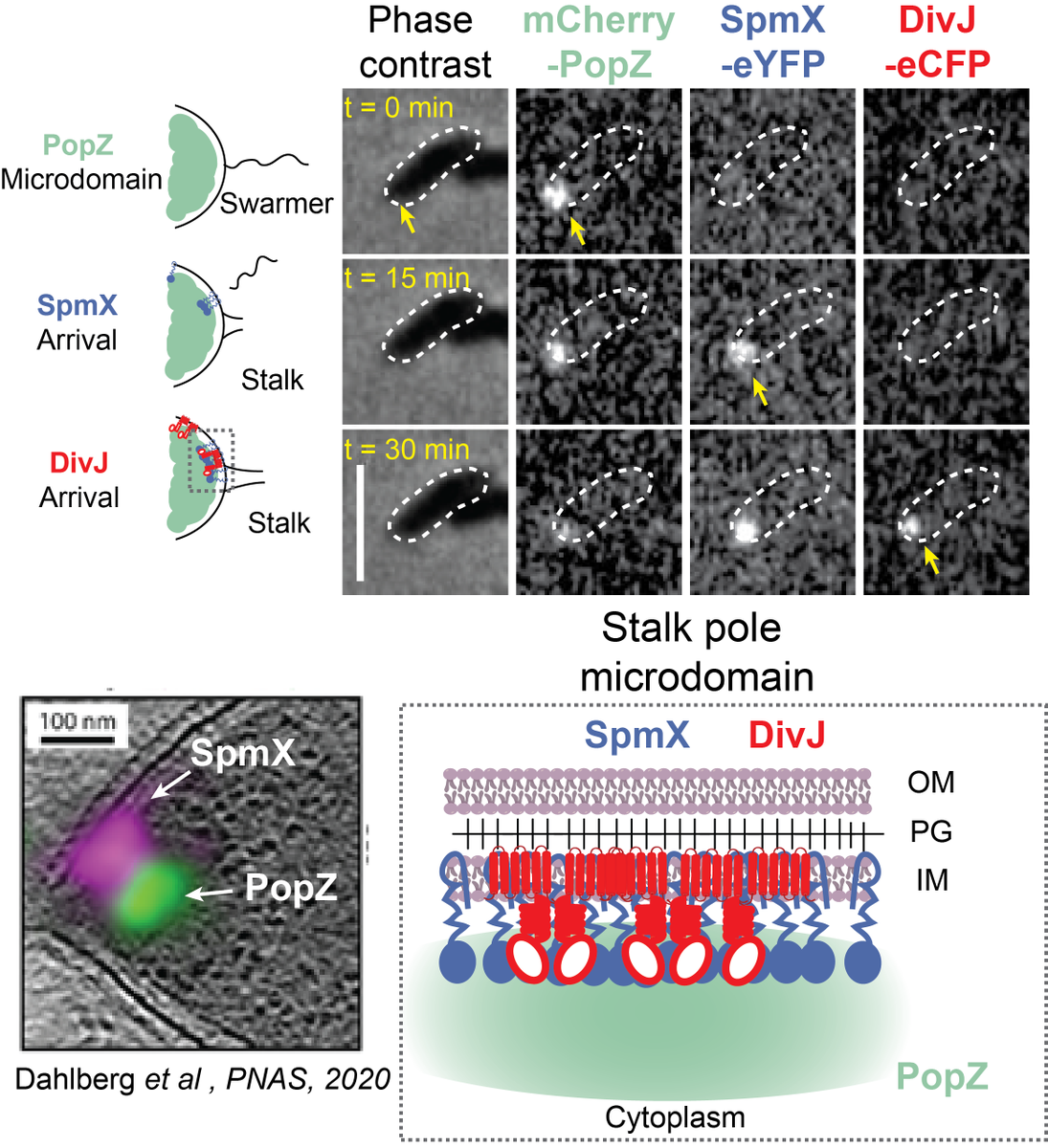
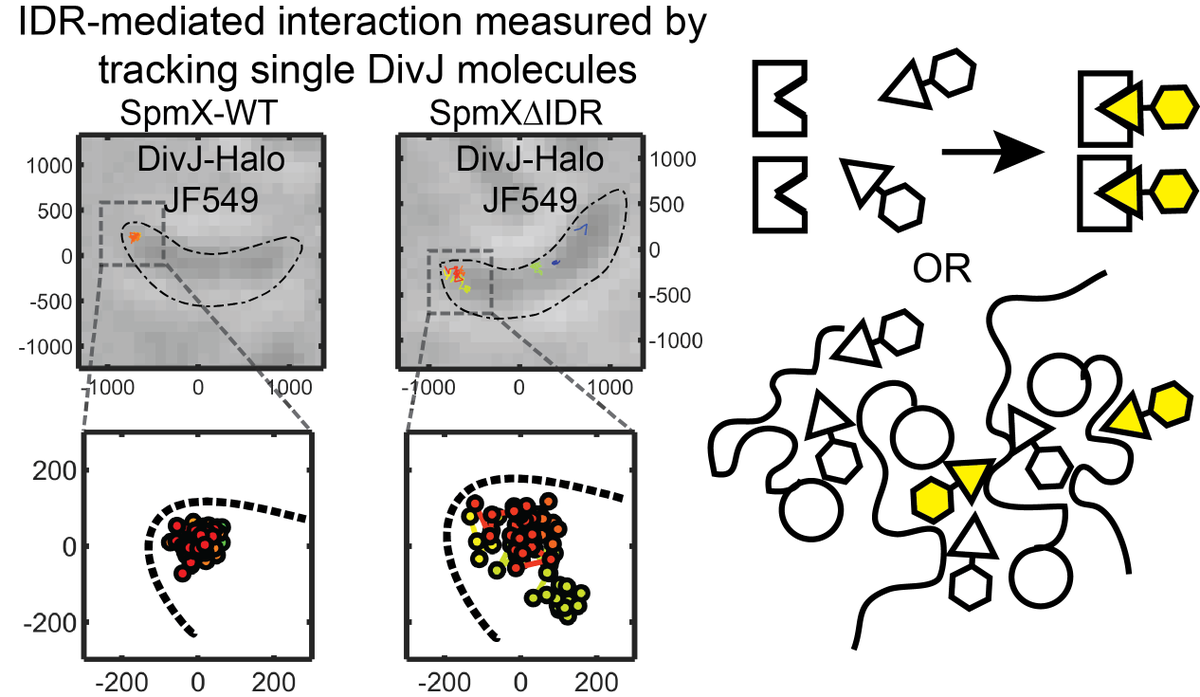 and https://abs.twimg.com/emoji/v2/... draggable="false" alt="🔑" title="Schlüssel" aria-label="Emoji: Schlüssel">) could have sufficed. However, the SpmX-DivJ interaction is mediated by the SpmX-IDR. Why use a charged and disordered condensate for this job? 5/14" title="For a cooperative reaction (such as DivJ phosphorylation), localization via structured protein interactions (https://abs.twimg.com/emoji/v2/... draggable="false" alt="🔒" title="Schloss" aria-label="Emoji: Schloss"> and https://abs.twimg.com/emoji/v2/... draggable="false" alt="🔑" title="Schlüssel" aria-label="Emoji: Schlüssel">) could have sufficed. However, the SpmX-DivJ interaction is mediated by the SpmX-IDR. Why use a charged and disordered condensate for this job? 5/14" class="img-responsive" style="max-width:100%;"/>
and https://abs.twimg.com/emoji/v2/... draggable="false" alt="🔑" title="Schlüssel" aria-label="Emoji: Schlüssel">) could have sufficed. However, the SpmX-DivJ interaction is mediated by the SpmX-IDR. Why use a charged and disordered condensate for this job? 5/14" title="For a cooperative reaction (such as DivJ phosphorylation), localization via structured protein interactions (https://abs.twimg.com/emoji/v2/... draggable="false" alt="🔒" title="Schloss" aria-label="Emoji: Schloss"> and https://abs.twimg.com/emoji/v2/... draggable="false" alt="🔑" title="Schlüssel" aria-label="Emoji: Schlüssel">) could have sufficed. However, the SpmX-DivJ interaction is mediated by the SpmX-IDR. Why use a charged and disordered condensate for this job? 5/14" class="img-responsive" style="max-width:100%;"/>
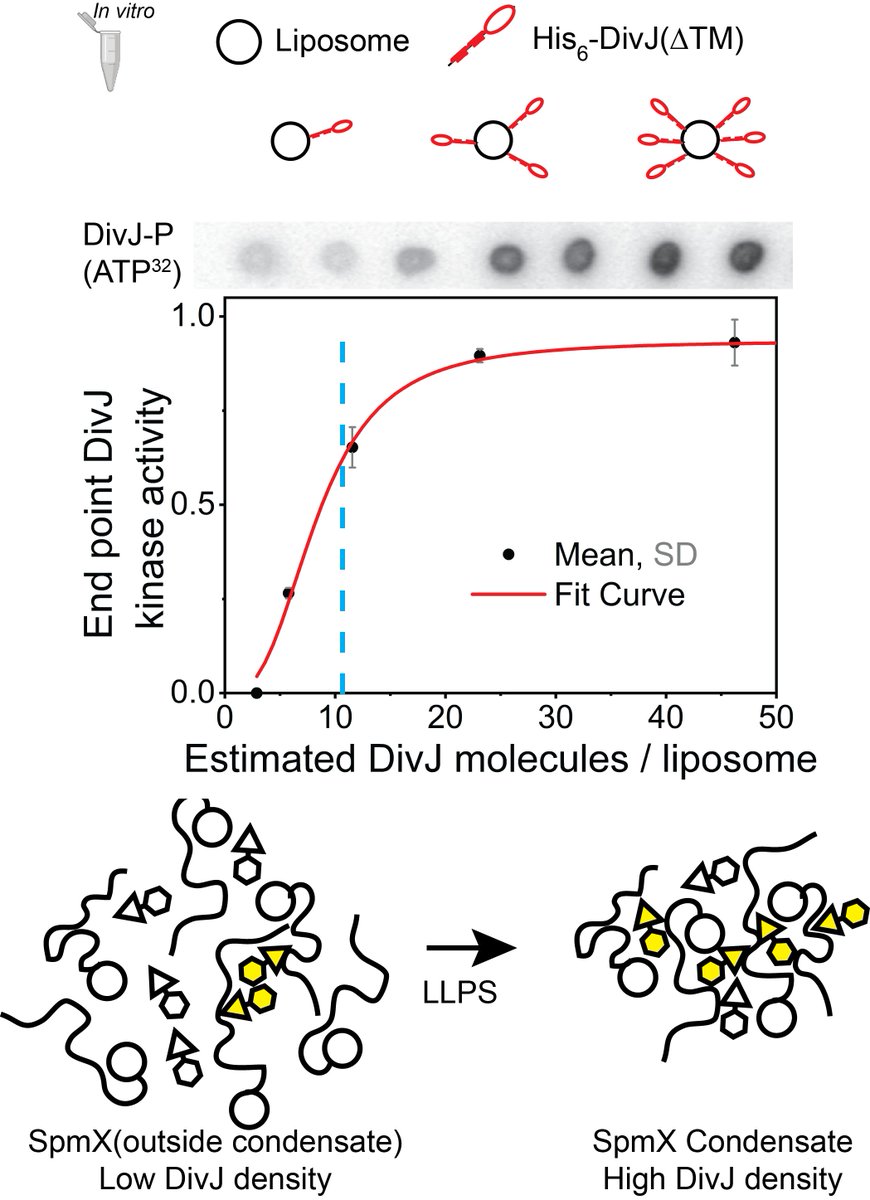
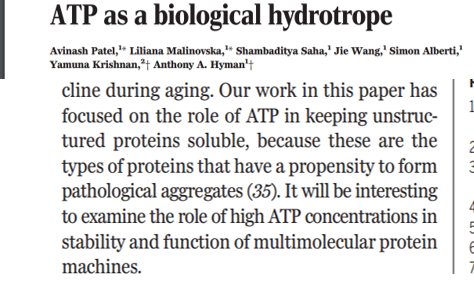 we asked is: what tunes the properties of SpmX & PopZ "knobs" & what& #39;s the relevance to Caulobacter& #39;s lifestyle? Thanks to this work from @HymanLab #ATPnspired.7/14" title="Condensates are awesome because their physical properties change in response to stimuli. Like knobs. So, the next https://abs.twimg.com/emoji/v2/... draggable="false" alt="❓" title="Rotes Fragezeichen-Symbol" aria-label="Emoji: Rotes Fragezeichen-Symbol">we asked is: what tunes the properties of SpmX & PopZ "knobs" & what& #39;s the relevance to Caulobacter& #39;s lifestyle? Thanks to this work from @HymanLab #ATPnspired.7/14" class="img-responsive" style="max-width:100%;"/>
we asked is: what tunes the properties of SpmX & PopZ "knobs" & what& #39;s the relevance to Caulobacter& #39;s lifestyle? Thanks to this work from @HymanLab #ATPnspired.7/14" title="Condensates are awesome because their physical properties change in response to stimuli. Like knobs. So, the next https://abs.twimg.com/emoji/v2/... draggable="false" alt="❓" title="Rotes Fragezeichen-Symbol" aria-label="Emoji: Rotes Fragezeichen-Symbol">we asked is: what tunes the properties of SpmX & PopZ "knobs" & what& #39;s the relevance to Caulobacter& #39;s lifestyle? Thanks to this work from @HymanLab #ATPnspired.7/14" class="img-responsive" style="max-width:100%;"/>
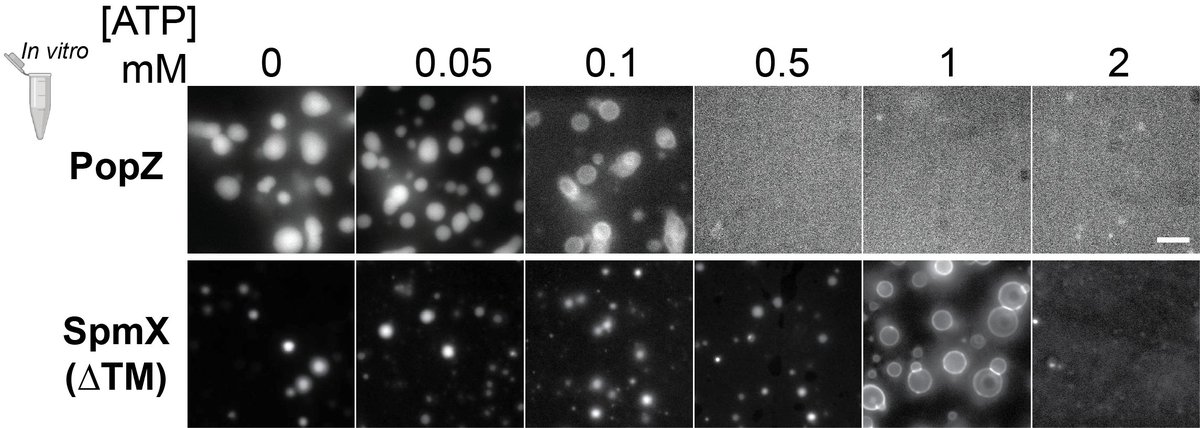
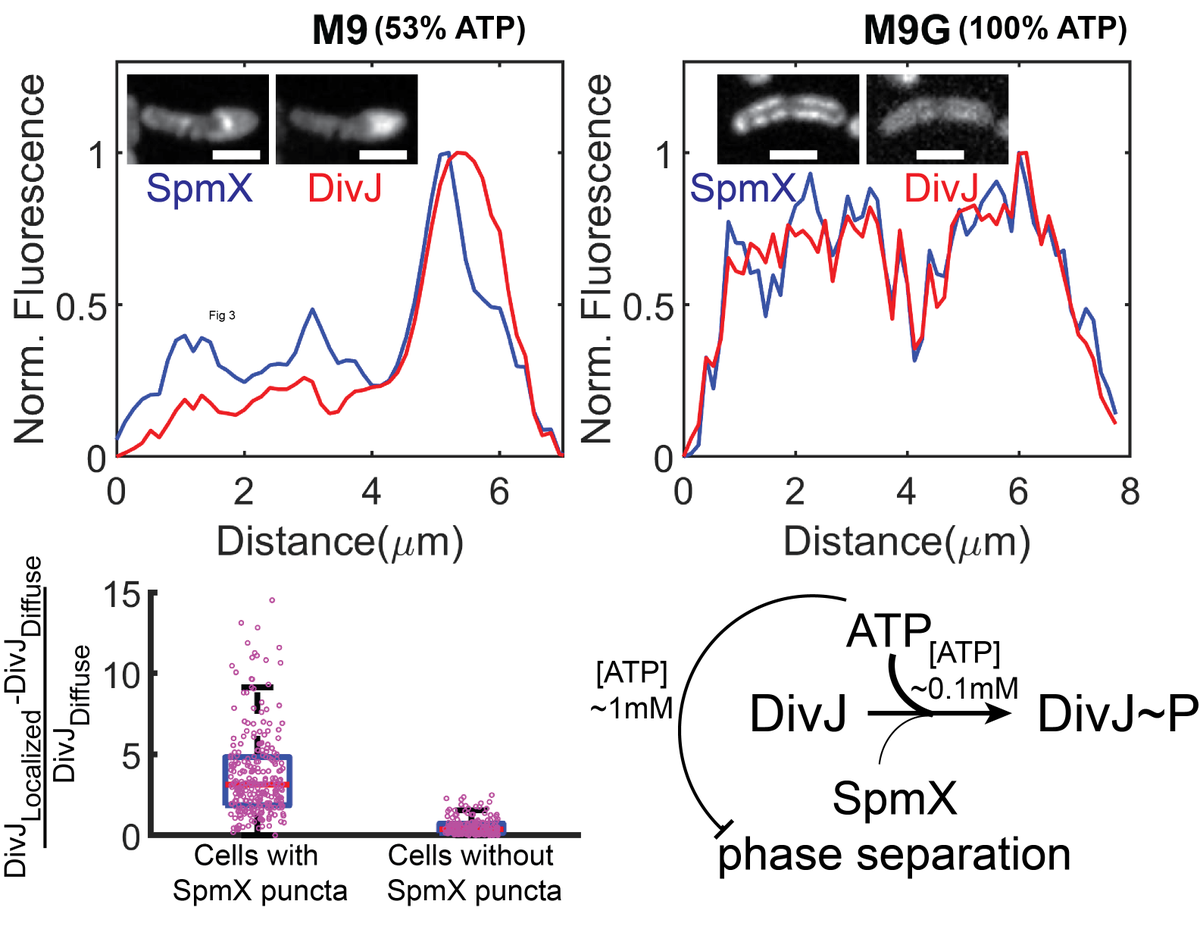
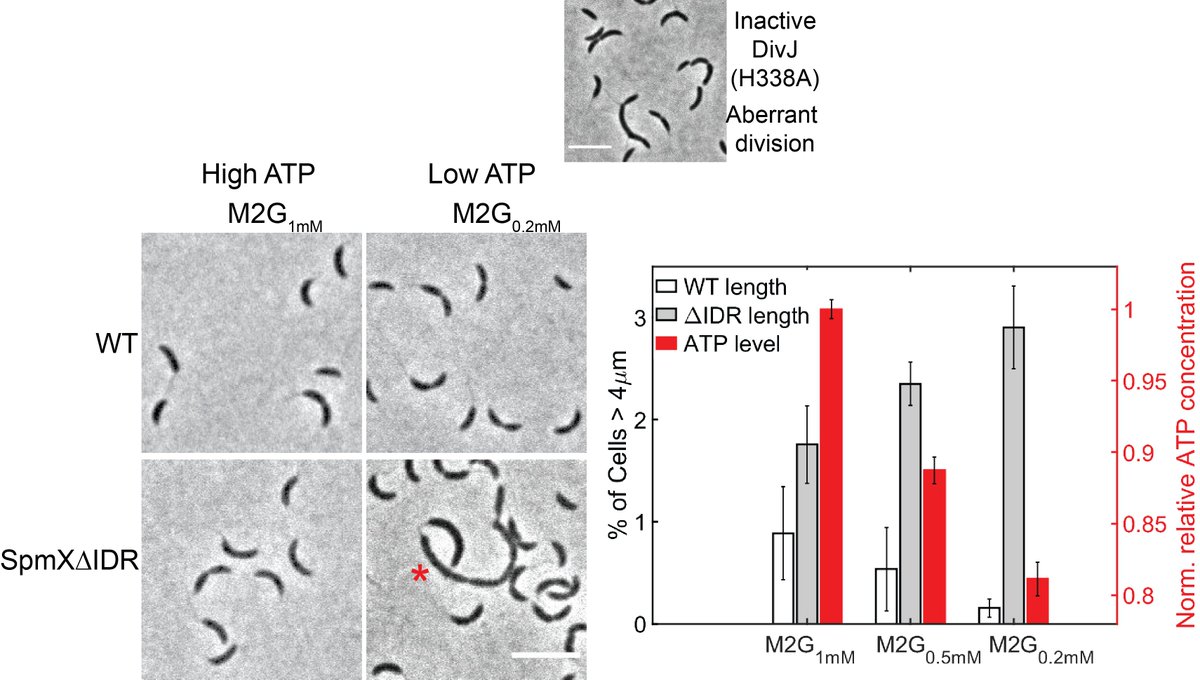
![TLDR: SpmX phase separation tunes DivJ activity in response to DivJ’s substrate availability; boosting the activity at low [ATP]. Our work implies that cooperativity of an enzyme in a condensate is not a (Hill) constant but varies as the condensate& #39;s response to hydrotrope. 12/14 TLDR: SpmX phase separation tunes DivJ activity in response to DivJ’s substrate availability; boosting the activity at low [ATP]. Our work implies that cooperativity of an enzyme in a condensate is not a (Hill) constant but varies as the condensate& #39;s response to hydrotrope. 12/14](https://pbs.twimg.com/media/EfLv3EPU4AAV6Au.jpg)


